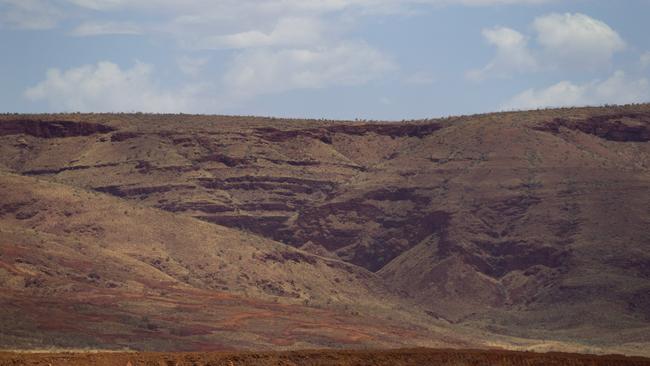Rio Tinto flags inflation hit to come as production lifts
The miner has lifted quarterly production, but half-year iron ore exports still lag on the back of labour shortages and Covid-19 spread.

Business
Don't miss out on the headlines from Business. Followed categories will be added to My News.
Rio Tinto’s flagship Pilbara iron ore operations put in an improved performance in the June quarter, but the mining major has warned shareholders that a slowing global outlook and falling commodity prices may put pressure on its business.
‘Rio Tinto delivered its quarterly production report on Friday, as benchmark iron ore prices dipped below the $US100 a tonne mark on fears a slowdown in the Chinese housing market will hit demand for crude steel and iron ore.
The iron ore slump looks set to continue, with the futures contracts traded on both the Singapore and Dalian exchange down again on Friday. Singapore futures shed $US3.29 a tonne to $US96.95 late on Friday.
Rio warned shareholders it faces a weakening global outlook for its key commodities, as Russia’s war on Ukraine hits global growth, and rising inflation across the world forces governments to tighten monetary policy.
“Prices for our commodities decreased in the quarter, amidst growing recession fears and a decline in consumer confidence. Trade disruptions, food protectionism and the global focus on securing energy supplies continue to put pressure on supply chains, which will need to be significantly eased before inflationary pressures subside,” Rio said.
“China’s industrial activity troughed in May amid COVID-lockdowns. June recovered but uncertainties remain given the potential for ongoing outbreaks. Economic stability is a focus, but headwinds are considerable from restricted labour and goods movement and a slowing external environment.”
Rio’s comments came as official figures showed Chinese growth has slowed to its lowest rate since the onset of the Covid-19 pandemic in early 2020, with China’s 0.4 per cent expansion in gross domestic product for the June quarter well below expectations, and suggesting China may well miss its 5.5 per cent growth target for the year.
Rio said it expects Beijing to launch further stimulus measures to spur growth when the threat of Covid lockdowns eases, but noted that China’s slowdown – and moves to curb inflation from central banks – had caused a sharp fall in prices across the suite of its commodities over the last two months.
Despite the downbeat outlook, Rio’s Pilbara mines shipped 79.9 million tonnes of iron ore in the quarter, up 5 per cent on the same time in 2021. But the skilled labour shortages in WA and the impact of the rapid spread of Covid-19 through the company’s Pilbara workforce in the first three months of the year mean Rio’s first-half exports of 151.4 million tonnes still remain behind their levels in the first half of 2021.
Rio said in its June quarter production report on Friday it was still on track to deliver on full-year iron ore export guidance of 320 to 335 million tonnes, as the company ramps up output at its new Gudai-Darri mine in the Pilbara.
Rio’s iron ore result is in line with consensus analyst estimates tipping exports from Rio’s Pilbara iron ore mines at about 80 million tonnes in the June quarter.
The entry of Gudai-Darri into Rio’s Pilbara system should deliver some welcome improvements in Rio’s flagship iron ore operations, with the mine set to supply high-grade iron ore to customers, lowering Rio’s Pilbara costs and improving the average grade of its iron ore shipments.
But the mining giant still faces plenty of other problems at the rest of its global operations, with Rio pointing to yet another cost and timeline blowout at its Oyu Tolgoi underground expansion as the company finalises its costings and work schedule for the long-delayed project.
Rio on Friday added another $US300m to the likely cost of the underground expansion, taking its likely total construction budget to $US7.06bn, and added another 6 months to its completion date.
When the company ticked off on the expansion it was supposed to cost $US5.3bn and enter global copper markets in early 2021. Rio says it now expects to commission the two main shafts at the underground mine in the first half of 2024.
Copper output from Oyu Tolgoi’s open pit operations rose slightly compared to the March period, to 10,200 tonnes – but that is almost 17 per cent lower than the June 2021 period.
Rio also warned its aluminium operations face a hit from rising costs and falling demand, trimming 2022 output guidance by about 100,000 tonnes of the industrial metal, to 3 to 3.1 million tonnes.
Rio pointed to a sharp increase in the cost of both energy and caustic soda across its alumina and aluminium operations, saying the cost environment – and recent falls in the aluminium price – were putting pressure on the business.
Rio’s alumina output fell 7 per cent in the June quarter, to 1.86 million tonnes, with aluminium production dwn 10 per cent to 731,000 tonnes.
But, despite recent price falls across its deck of commodities, Rio is still likely to deliver a strong first-half financial result – though it is likely to be lower than last year’s first-half profit given the softened iron ore price.
Rio said it was paid an average $US120.50 a dry metric tonne for its iron ore in the first half, at the port, down from $US168.40 in the first half of 2021.
But aluminium prices averaged $US3808 a tonne, up 45 per cent from the first of last year. Its copper was worth $US4.47 a pound, up from $US4.15.
Rio shares closed down $2.74, or 2.8 per cent, to $93.72 on Friday.



